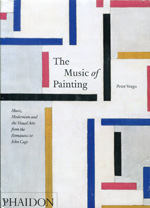The music of painting
music, modernism and visual arts from the romantics to John Cage
- ISBN: 9780714857626
- Editorial: Phaidon Press
- Fecha de la edición: 2010
- Lugar de la edición: London. Reino Unido
- Encuadernación: Cartoné
- Medidas: 23 cm
- Nº Pág.: 320
- Idiomas: Inglés

As a sequel to Phaidon's "That Divine Order", published in 2005, which surveyed the relationship between music and the visual arts from ancient times until the mid-eighteenth century, "The Music of Painting" continues this fascinating study in the period covering the emergence and development of Modernism, c.1850-1950. Composers and artists repeatedly borrowed from one another, yet their motives have seldom been explored. Professor Peter Vergo in this volume provides a broad analysis of changes in the character of the analogies drawn at different times, using in his analysis critical and philosophical sources as well as evidence about artistic and musical practice. Music has inspired some of the most progressive art of our time from the abstract painting of Wassily Kandinsky to the mid-century experimental films of Oskar Fischinger. Personalities as different in their background and outlook as FrantiA'ek Kupka and Paul Klee both created 'fugue' paintings. Similarly, a wide-spread admiration for the music of Johann Sebastian Bach, the acknowledged master of fugue, affected not only painters in Paris on the eve of the First World War such as Georges Braque but also artists at the Bauhaus during the 1920s including the American Lyonel Feininger and the Swiss Johannes Itten. Other Bauhaus artists, Klee and Kandinsky among them, devoted significant time and energy to examining whether it was possible to translate actual fragments of music or specific musical motifs into the language of visual art. The path that led from music to painting was, however, by no means a one-way street. Many musicians were influenced in their turn not just by ideas about art - for example, Claude Debussy's interest in the notion of visual arabesque - but by specific works of painting and sculpture, which in some cases they sought to 'represent' by purely musical means. Strongly influenced by Impressionist painters such as Whistler, Turner or Monet, Debussy, regarded as the founder of musical I






